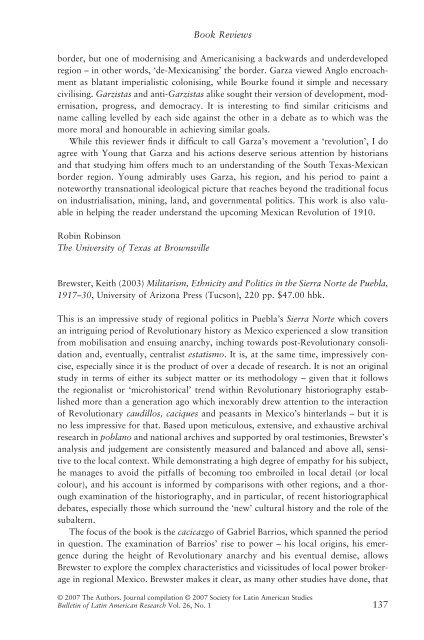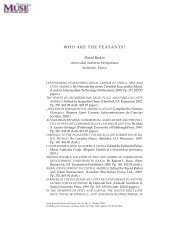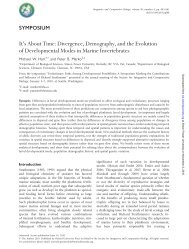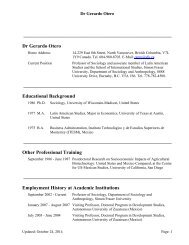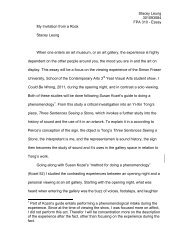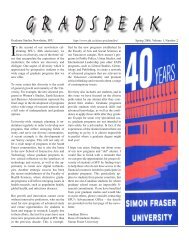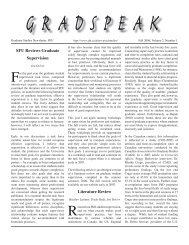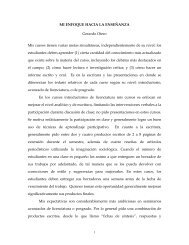Review of Mexico in Transition by Byron Crites
Review of Mexico in Transition by Byron Crites
Review of Mexico in Transition by Byron Crites
- TAGS
- transition
- byron
- crites
- cgi.sfu.ca
Create successful ePaper yourself
Turn your PDF publications into a flip-book with our unique Google optimized e-Paper software.
Book <strong>Review</strong>s<br />
border, but one <strong>of</strong> modernis<strong>in</strong>g and Americanis<strong>in</strong>g a backwards and underdeveloped<br />
region – <strong>in</strong> other words, ‘ de-Mexicanis<strong>in</strong>g ’ the border. Garza viewed Anglo encroachment<br />
as blatant imperialistic colonis<strong>in</strong>g, while Bourke found it simple and necessary<br />
civilis<strong>in</strong>g. Garzistas and anti- Garzistas alike sought their version <strong>of</strong> development, modernisation,<br />
progress, and democracy. It is <strong>in</strong>terest<strong>in</strong>g to fi nd similar criticisms and<br />
name call<strong>in</strong>g levelled <strong>by</strong> each side aga<strong>in</strong>st the other <strong>in</strong> a debate as to which was the<br />
more moral and honourable <strong>in</strong> achiev<strong>in</strong>g similar goals.<br />
While this reviewer fi nds it diffi cult to call Garza ’ s movement a ‘ revolution ’ , I do<br />
agree with Young that Garza and his actions deserve serious attention <strong>by</strong> historians<br />
and that study<strong>in</strong>g him <strong>of</strong>fers much to an understand<strong>in</strong>g <strong>of</strong> the South Texas-Mexican<br />
border region. Young admirably uses Garza, his region, and his period to pa<strong>in</strong>t a<br />
noteworthy transnational ideological picture that reaches beyond the traditional focus<br />
on <strong>in</strong>dustrialisation, m<strong>in</strong><strong>in</strong>g, land, and governmental politics. This work is also valuable<br />
<strong>in</strong> help<strong>in</strong>g the reader understand the upcom<strong>in</strong>g Mexican Revolution <strong>of</strong> 1910.<br />
Rob<strong>in</strong> Rob<strong>in</strong>son<br />
The University <strong>of</strong> Texas at Brownsville<br />
Brewster, Keith (2003) Militarism, Ethnicity and Politics <strong>in</strong> the Sierra Norte de Puebla,<br />
1917 – 30 , University <strong>of</strong> Arizona Press (Tucson), 220 pp. $47.00 hbk.<br />
This is an impressive study <strong>of</strong> regional politics <strong>in</strong> Puebla ’ s Sierra Norte which covers<br />
an <strong>in</strong>trigu<strong>in</strong>g period <strong>of</strong> Revolutionary history as <strong>Mexico</strong> experienced a slow transition<br />
from mobilisation and ensu<strong>in</strong>g anarchy, <strong>in</strong>ch<strong>in</strong>g towards post-Revolutionary consolidation<br />
and, eventually, centralist estatismo . It is, at the same time, impressively concise,<br />
especially s<strong>in</strong>ce it is the product <strong>of</strong> over a decade <strong>of</strong> research. It is not an orig<strong>in</strong>al<br />
study <strong>in</strong> terms <strong>of</strong> either its subject matter or its methodology – given that it follows<br />
the regionalist or ‘ microhistorical ’ trend with<strong>in</strong> Revolutionary historiography established<br />
more than a generation ago which <strong>in</strong>exorably drew attention to the <strong>in</strong>teraction<br />
<strong>of</strong> Revolutionary caudillos, caciques and peasants <strong>in</strong> <strong>Mexico</strong> ’ s h<strong>in</strong>terlands – but it is<br />
no less impressive for that. Based upon meticulous, extensive, and exhaustive archival<br />
research <strong>in</strong> poblano and national archives and supported <strong>by</strong> oral testimonies, Brewster ’ s<br />
analysis and judgement are consistently measured and balanced and above all, sensitive<br />
to the local context. While demonstrat<strong>in</strong>g a high degree <strong>of</strong> empathy for his subject,<br />
he manages to avoid the pitfalls <strong>of</strong> becom<strong>in</strong>g too embroiled <strong>in</strong> local detail (or local<br />
colour), and his account is <strong>in</strong>formed <strong>by</strong> comparisons with other regions, and a thorough<br />
exam<strong>in</strong>ation <strong>of</strong> the historiography, and <strong>in</strong> particular, <strong>of</strong> recent historiographical<br />
debates, especially those which surround the ‘ new ’ cultural history and the role <strong>of</strong> the<br />
subaltern.<br />
The focus <strong>of</strong> the book is the cacicazgo <strong>of</strong> Gabriel Barrios, which spanned the period<br />
<strong>in</strong> question. The exam<strong>in</strong>ation <strong>of</strong> Barrios ’ rise to power – his local orig<strong>in</strong>s, his emergence<br />
dur<strong>in</strong>g the height <strong>of</strong> Revolutionary anarchy and his eventual demise, allows<br />
Brewster to explore the complex characteristics and vicissitudes <strong>of</strong> local power brokerage<br />
<strong>in</strong> regional <strong>Mexico</strong>. Brewster makes it clear, as many other studies have done, that<br />
© 2007 The Authors. Journal compilation © 2007 Society for Lat<strong>in</strong> American Studies<br />
Bullet<strong>in</strong> <strong>of</strong> Lat<strong>in</strong> American Research Vol. 26, No. 1 137


